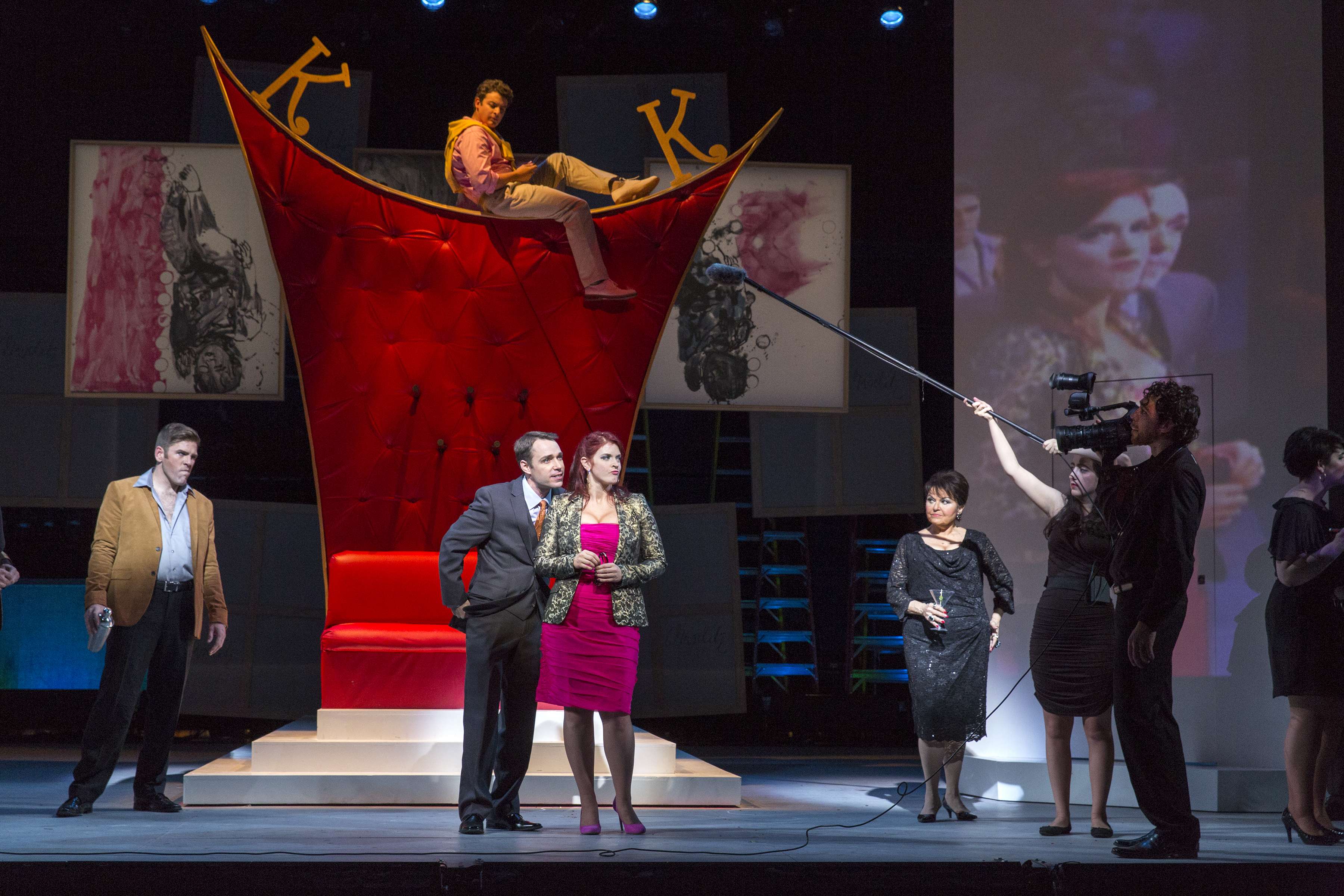|
Back
Time Travel New York
Gerald W. Lynch Theater
10/23/2013 - & October 25*, 26, 29, 2013
“Baden-Baden 1927”
Darius Milhaud: L’Enlèvement d’Europe, opus 94
Ernst Toch: Die Prinzessin auf der Erbse, opus 43
Paul Hindemith: Hin und Zurück, opus 45a
Kurt Weill: Mahagonny-Songspiel
John Cheek (Agénor), Michael Mayes (Pergamon), Daniel Montenegro (Jupiter), Maeve Hoglund (Europa)
John Cheek (The King), Helen Donath (The Queen), Daniel Montenegro (The Prince), Maeve Hoglund (A Foreign Princess), Michael Mayes (The Chancellor), Michael Tuell (The Minister), Jennifer Rivera (The Nurse)
Matthew Tuell (Robert), Maeve Hoglund (Helene), Michael Mayes (The Professor), John Cheek (The Ambulance Driver), Daniel Montenegro (Wise Man), Jessica Ann Best (Aunt Emma), Rachelle Pike (The Maid)
Daniel Montenegro (Charlie), Matthew Tuell (Billy), Michael Mayes (Bobby), John Cheek (Jimmy), Helen Donath (Jessie), Jennifer Rivera (Bessie)

(© Richard Termine/G. C. O.)
The first three decades of the 20th century in Europe were a time of ferment and creativity in all the arts. And then, of course, much of the world was plunged into darkness and horror by war. “What is art?” seemed a particularly salient question for the time. And, indeed, it was this question that was posed at an avant garde music festival in Baden-Baden, in 1927. The organizer of the festival, Paul Hindemith, decided to present four short, so-called zeitoper (loosely defined as works about happenings at the time.) He wrote one himself and invited three colleagues to join him in the program. Neal Goren, the imaginative creator and director of The Gotham Chamber Opera, hit upon the idea of revisiting that time and these works and came up with an inventive, entertaining, and visually striking production that is “Baden-Baden 1927”.
The production by Paul Curran (very appropriately, given the subject matter) has sets by the German neo-expressionist painter, Georg Baselitz who worked with Court Watson. The sets for all the operas except the Hindemith are bright and richly colored. One of Baselitz’s paintings is the centerpiece of the first opera, which is set in an art gallery.
Of the four works, the only one with an afterlife is Kurt Weill’s first collaboration with Bertolt Brecht, Mahagonny-Songspiel. Musically it was extremely well done with standout performances by Jennifer Rivera as Bessie and Helen Donath who sang the role of Jessie that was later taken and made iconic by Lotte Lenya. Rivera and Donath gave a marvelous account of “The Alabama Song.” The four men in the cast also turned in fine performances. The set seemed to take us back into an art gallery of sorts, but it featured four large treadmills. The heavy handed symbolism of characters trudging along but getting nowhere produced a visual sour note.
Hindemith’s Hin und Zurück staged in black and white (with superb projections by Driscoll Otto), was rather like a newsreel running forward and then backwards in a palindromic structure. The opera opened with a domestic scene, interrupted by a letter (from the wife’s lover). There followed a murder by the jealous husband, the arrival of an ambulance to take the wife’s body away, and finally a suicide. But then, came an intervention by a character (the excellent Daniel Montenegro), who was made up to resemble Andy Warhol. The events were reversed and we were left with the contented couple in their kitchen. Hindemith’s answer to the query framing the operas is clear: Art is what the artist wants it to be.
Of the four, my musical favorite was Toch’s Die Prinzessin auf der Erbse, a satirical retelling of Hans Christian Anderson’s fairy tale featuring a princess whose sleep is disturbed by a solitary pea at the bottom of a pile of mattresses. In the fairy tale, the family of the prince uses the test of the pea to select a bride of the appropriate social status. She had to be sensitive (literally) and thus she would be worthy. Curran’s idea to present this opera in the context of a reality television program with the princess as a Kim Kardashian figure (famous only for being famous) contradicts the meaning of the tale in every respect. It was a lot of fun to watch though – the gigantic images taken by a cameraman who knew no limits (even positioning himself over the princess as she lay on her bed), the vibrant colors and over the top décor, and the emotional outburst of the princess at not being able to get a good night’s sleep. The music was lively, unpredictable, and full of jagged harmonies, energy, and humor. The singers were superb particularly Helen Donath as the scheming mother of the prince determined to find just the right bride for her son. Maeve Hoglund as the princess sang with color and character. Also excellent were Jennifer Rivera as the nurse and John Cheek as the King.
This opera – and, indeed, the entire evening – was stolen by the appearance of the legendary Helen Donath, a favorite of illustrious conductors including von Karajan and George Solti. She has sung and recorded with singers from Fischer-Dieskau to Pavarotti. And now she was back not just singing with lovely tone and great characterization, but also serving as a sassy mistress of ceremonies for part of the evening. It was a joy to have her with us.
Arlene Judith Klotzko
|